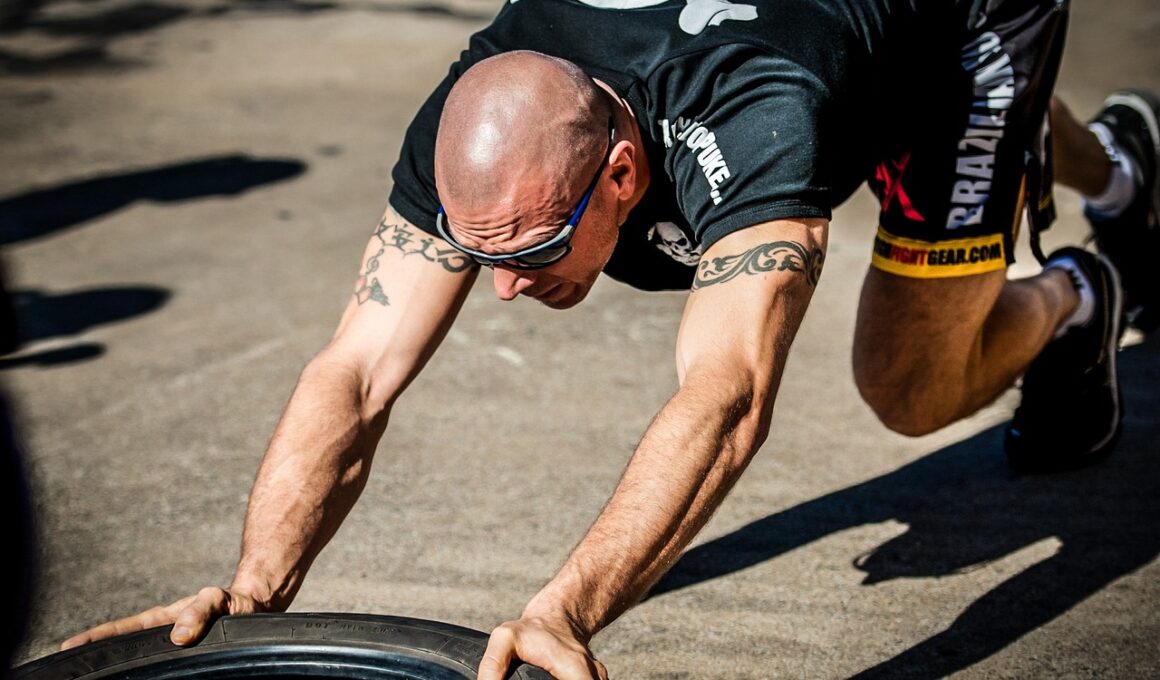Building Strength Through Functional Training Basics
Functional training is a fitness approach emphasizing movements in a way that simulates real-life activities. This method promotes overall strength by engaging various muscle groups simultaneously, enhancing both strength and mobility effectively. One of the core principles of functional training is that it prepares your body for everyday tasks, whether it’s lifting groceries or climbing stairs. Unlike traditional strength training, which isolates muscle groups, functional training develops coordination and balance through compound movements. Exercises such as squats, lunges, and push-ups are fundamental components of functional routines. Specifically, they improve joint stability and overall flexibility, contributing to a more resilient body. Functional training can also help prevent injuries, as it develops strength in a more dynamic way. Additionally, it supports better posture and reduces back pain, crucial for a healthy lifestyle. To take advantage of functional training, you can incorporate it into your regular exercise routine. It’s essential to focus on form instead of lifting heavy weights initially. Always consult professionals to design a personalized functional training plan that meets your goals and keeps you safe.
Understanding the principles of functional training further highlights its benefits in enhancing daily physical capabilities. By emphasizing core stability, functional training builds a strong foundation for the entire body. A strong core stabilizes the spine and pelvis, allowing for effective force transmission throughout the body during various exercises. Not only does a robust core assist in lifts, but it also protects against injuries in more dynamic activities. Another key aspect is the concept of movement patterns, rather than fixed exercises. Movements such as hinging, pushing, pulling, and squatting replicate everyday activities, effectively translating gym efforts into functional benefits. Also, factor in the incorporation of balance and coordination exercises. These are vital for developing proprioception, which enables individuals to sense their body’s position. Activities like single-leg exercises and unstable surface training enhance one’s awareness and response. Furthermore, functional training can be performed with minimal equipment, making it accessible for home workouts. Bodyweight exercises can be incredibly effective, proving that you don’t always need a well-equipped gym to achieve your fitness goals. Ultimately, functional training fosters a holistic approach, promoting sustainable health and fitness.
As you delve deeper into functional training, it becomes important to learn about some basic exercises included in typical routines. First, the squat is indispensable. This exercise mimics the act of sitting and standing, directly translating to improved mobility in daily tasks. Incorporating variations such as goblet squats even intensifies strength gains. Next, lunges are equally vital to enhance leg strength, balance, and flexibility. They can be performed in various directions, adding complexity that translates well into lateral movements important for sports and recreational activities. Additionally, push-ups are fundamental for upper body strength, engaging not only the chest and arms but also stabilizing the core. Them can be modified and progressed to fit any fitness level. Another essential component is the deadlift, which utilizes large muscle groups and promotes good posture. Lastly, planks are key in developing core stability. They train endurance and not merely strength. Hence, including these exercises leads to a well-rounded functional training program. With these fundamentals, you can progress to more advanced movements over time. This adaptability is the beauty that functional training offers to all fitness enthusiasts.
The Role of Equipment in Functional Training
While functional training heavily relies on bodyweight exercises, integrating equipment elevates the training experience and increases results. Resistance bands, for instance, are an excellent tool that adds versatility to your routines. They provide varying levels of resistance and can work multiple muscle groups effectively. Utilizing bands can help increase strength without heavy weights, making them perfect for rehabilitation or beginners. Dumbbells and kettlebells are also popular choices; they facilitate various dynamic movements that align with functional training principles. Exercises like kettlebell swings improve power and coordination while mimicking daily movements. Additionally, stability balls are useful for enhancing balance and core strength. They can be incorporated into exercises such as ball squats or push-ups to add a new challenge. Medicine balls are another fantastic tool, perfect for explosive movements that link strength, balance, and coordination together. They enhance the functional aspect of training by incorporating multi-joint and multi-plane movements. Ultimately, exploring different equipment options enhances functional training and keeps workouts exciting and motivating. Whether at home or in the gym, the adaptability of functional training is one of its core appeals.
Nutrition is an essential component of anyone’s functional training regimen. It supports the performance of exercises and recovery afterward. To maximize strength-building, focusing on a balanced diet is crucial. Incorporating proteins, healthy fats, and complex carbohydrates into meals ensures that the body receives the required nutrients for recovery and muscle growth. Proteins are especially vital, as they help repair and build muscles after workout sessions. Foods such as lean meats, eggs, legumes, and dairy provide the necessary building blocks. Healthy fats from nuts, seeds, and avocados offer sustained energy, enhancing performance during workouts. Furthermore, complex carbohydrates from whole grains and vegetables provide the energy required to fuel exercises efficiently. Hydration must not be overlooked either. Water intake is necessary to ensure peak performance, particularly during intense workouts. Additionally, recovery meals following workouts should focus on a balance of proteins and carbs to support muscle recovery effectively. Consistency in both training and nutrition leads to optimal results in functional training. Finally, consider meal prepping for easier access to healthy meals. This practice supports adherence to a nutritious diet and training schedule.
Incorporating Functional Training into Your Lifestyle
Integrating functional training into your lifestyle is a manageable but rewarding endeavor. Start by identifying activities throughout your day which could benefit from an added functional training perspective. For example, consider using your body weight while performing routine tasks, such as balancing while cooking or standing on one leg during phone calls. You can turn everyday activities into mini functional workouts, enhancing your strength and balance unconsciously. It’s also imperative to set realistic goals that ensure long-term motivation and success. Establishing specific, measurable, achievable, relevant, and time-bound (SMART) goals can help you stay focused on your fitness journey. Moreover, consider scheduling regular workouts to cultivate a routine. Consistency is key to acquiring and maintaining functional fitness levels. Joining a functional training class also offers community support and expert guidance, which can enhance your experience significantly. Accountability from others can drive your dedication to functional training. Another option is to find a workout buddy, which can provide motivation and introduce a fun element to your training sessions. Remember that progress takes time and attention, so celebrate small victories along the way to boost motivation.
As you reflect on the key components of functional training, remember to listen to your body and make adjustments whenever necessary. Every individual’s journey is unique, and how one responds to functional training may vary. Pay attention to your energy levels and how your body reacts to certain exercises. If something feels painful, consider modifying the approach, decreasing intensity, or consulting a fitness professional. Tracking progress is also a crucial aspect of a successful functional training journey. Maintaining a fitness journal helps you document your workouts, note improvements in strength and endurance, and highlight areas that may require more focus. Finally, recognize the importance of rest days as part of a comprehensive training approach. Allowing the body to recover is essential for muscle repair and growth. Engaging in activities such as gentle stretching or yoga can promote relaxation and increased flexibility on off days. Ultimately, functional training is more than a workout plan; it’s a holistic approach to enhancing daily physical performance and overall well-being. With dedication and consistency, anyone can reap the incredible benefits of functional training. Embrace this effective method for improved strength!
Embracing functional training goes beyond just improving physical strength; it actively supports mental health as well. It fosters a sense of accomplishment that can boost self-esteem and bolster confidence. When individuals observe improvements in their physical capabilities, the psychological benefits are also noticeable. Functional training encourages engaging in physical activity that makes you feel empowered and capable. This mental aspect is crucial, especially in today’s fast-paced world, where stress levels can be high. Taking time to focus on functional training can also serve as an excellent stress reliever, allowing individuals to unwind from daily pressures. In the long run, creating a balance between physical exertion and adequate recovery promotes mental clarity and emotional stability. Additionally, functional training builds connections with others, whether through classes or group workouts. Elevating the community aspect of fitness fosters motivation and accountability, which further enhances commitment. Moreover, as you grow more proficient in functional training, consider embracing challenges like outdoor activities or sports that require agility. This shift into applying your functional strength in novel situations enriches your overall fitness experience. By blending functional training with mental well-being, you cultivate a more comprehensive lifestyle that cherishes both body and mind.


